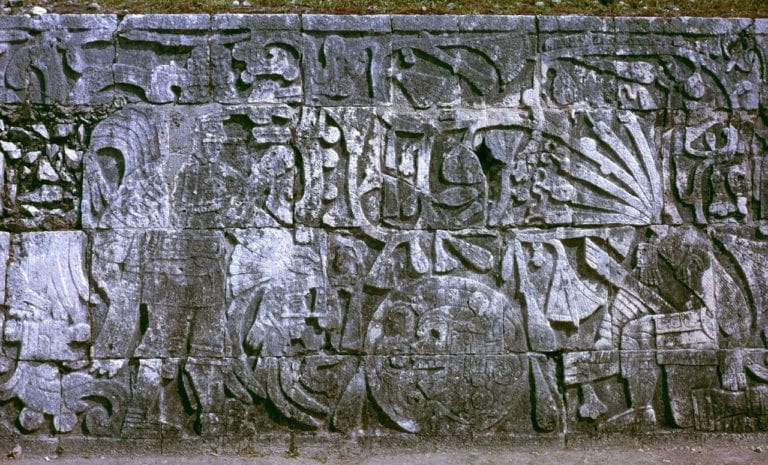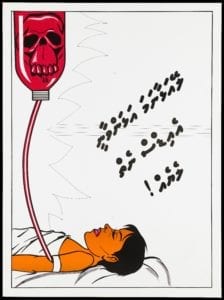E.C. Spary
United Kingdom

Blood, that vivid liquid within our bodies, has an attraction for human cultures that is apparent from at least the time of the Maya civilization. If many in the West know of chocolate’s origins in pre-Columbian practices, few are aware that the original drink was composed to resemble fresh blood: liquid, nourishing, warm, and also red. One of its usual ingredients, as documented in Maya recipes recorded by Spanish scholars, was annatto, a dye plant which conferred a reddish tinge upon the familiar brown of the roasted cacao bean.1 Christian cultures of the early modern period adopted the American beverage complete with several of its Mayan additives—vanilla, chilli pepper, and annatto. But the red dye, though initially recorded in European chocolate recipes, was quickly abandoned there. Chocolate became a new kind of drink: fashionable, highly expensive, nourishing, but unequivocally brown.
Perhaps this was just as well, in the eyes of the Catholic Church. For well into the seventeenth century, after the Spanish were already established across South and Central America, the Maya apparently continued to place blood at the very heart of religious rituals. Human sacrifice was the supreme gift to the gods; Spanish narrators described blood on display in decapitation ceremonies, or when still-beating hearts were excised from the victim’s body.2 (Figure 1) The instrumental role of the blood-drink of chocolate in Maya and Aztec ritual could not have escaped Spanish missionaries and officials. Chocolate could only be theologically neutralized by obliterating any relationship with human blood.

This is not to say that Christians themselves eschewed communal blood-drinking, however. Wine’s symbolism as the blood of Christ in the Eucharist is well known, and was perhaps the very reason why non-Christian blood rituals were presented as at once similar and frightful. At a time when religious tensions divided early modern Europe, fear of misappropriation of the Eucharist was widespread. In 1725, Frombald, imperial official of the House of Habsburg, reported to his superiors in Vienna on an epidemic disease of vampirism afflicting a borderland territory recently recaptured from Ottoman rule, populated by Muslim families that the Habsburgs hoped to restore to Christian belief. This terrible affliction caused locals to rise from the grave by night to drink blood, in a quasi-Eucharistic ritual which raised the specter that reconversion might lead to perversion rather than purification of belief. “In his mouth I saw, not without astonishment, some fresh blood, which all agreed he had sucked from those he murdered.”3
In European medicine, blood long possessed a largely positive valence as one of the four bodily humors. People in whom blood predominated over bile, phlegm, or melancholy had a sanguine temperament—generally agreed by doctors to be the healthiest of constitutions, and most often found among men.4 The term “sanguine” has passed into current usage to describe a level-headed, cheerful personality or attitude. A tendency to suffer from a repletion of blood, also known as plethora, was a potential health danger to be treated both by avoiding nourishing foods that generated blood, and by blood-letting or phlebotomy, a specialist practice executed by the barber-surgeon. Surgeons prided themselves on their virtuosity with blood, showing off their control over its flow by directing the streams coming from the incised vein of their client in entertaining ways. (Figure 2)

In short, the management of blood was just as ritualized in early modern European medical encounters as in Maya temples. Such was the hold of phlebotomy over Europeans that they even interpreted the cultural rituals of other peoples in this light, as in “The Indians Manner of Bleeding,” as the London engraver James Hulett characterized Carib practices of body scarification. For Caribs, blood-letting was an adolescent rite of passage, denoting readiness for marriage and procreation—but for Hulett, it demonstrated the global medical utility of phlebotomy, such that even supposedly “primitive” peoples practiced it.5 (Figure 3)
From well before the 1610s, when the English physician William Harvey first began to teach that blood circulated, authors had metaphorically equated it with wealth, sharing the role of sustaining life and activity, whether in the body or the body politic.6 Emerging from the body, blood was fluid, brilliant, and mobile. Its excessive loss meant certain death, yet it could not be preserved in liquid form, quickly turning dry and brown. Such “dead” blood served as both medicine and crop fertilizer; the menstrual blood of virgins, a particularly prized curative, was collected and peddled by women in seventeenth-century Paris.7 Artificial management of flows of both money and blood was an exciting prospect for natural philosophers, doctors, and economic authors from the seventeenth century onwards. Countless benefits were foreseen from mastering blood, some rooted in older, magical practices, others in newer claims about blood as the vehicle of vital spirit. “Money is the vitall spirit of trade, and if the spirits faile, needs must the body faint,” observed one English merchant in 1622.8 Transmitting these life-giving, health-restoring, energetic and vivifying powers of fresh blood to another person also intrigued early modern doctors seeking a cure for recalcitrant conditions like insanity.9 Though reliable transfusion techniques remained elusive—both animal and human experimental subjects often died—blood continued to be viewed as a resource that should be managed, and a symbol of life, strength, and prosperity. A suite of caricatures from the Napoleonic Wars onwards underscored the relationship between excessive blood loss and the risk posed to national prosperity by unscrupulous or inept surgeon-politicians. (Figure 4) Although phlebotomy declined in medical standing over the nineteenth century, the money metaphor endured.

Perhaps it was this interchangeability of bodily with national prosperity that nurtured new genres of fictional blood writing in the nineteenth century, some still well-known today. The Victorian novelist Mary Braddon, in her short story “Good Lady Ducayne” (1896)—written at the age of sixty—reimagined blood transfusion as an attempt by the elderly to steal life force from the young. Well-known vampire tales such as J. Sheridan Lefanu’s “Carmilla” (1871–2), or, more famously, Bram Stoker’s Count Dracula (1897), famously explored the power, economic, and gender relations of polite society by imagining the perpetuation of life beyond the grave through blood-drinking.10 Such stories probed the darker corners of nineteenth-century disquiet about elite lifestyles draining the vitality of more vulnerable members of society, or in other words the dependency of rich upon poor, old upon young, male upon female.

Conversely, new kinds of worries about hereditary vices “in the blood” were also apparent, fostered by the well-known hemophilia in Queen Victoria’s family. Blood stood for heredity, birth, and breeding, top priorities for nineteenth-century Western elites. Animal breeders and human matchmakers took pains to avoid introducing “bad blood” into the “bloodline” of horses or families.11 Blood was no longer just the vector of life and vigor; increasingly, it was a covert source of long-lasting, intergenerational damage. A similar concern about the mingling of self and other entailed by mixing the blood is evident in more recent public concerns about HIV, especially before the advent of successful drug therapies. The absence of visible symptoms in the early stages meant that HIV remained a condition only detectible “in the blood.” Transfusion, always a morally complex coalescence with the other, here risked incorporating into the body not health but harm, something vividly illustrated in contemporary health advice. (Figure 5)
Theft of youth, blood-drinking, and occult harm remain resurgent themes in today’s debates over who owns blood, in both medical debate and popular culture. Blood is not merely paradoxical because of its relationship with life and death, but also because it is both “self” and not “self”—a substance from one body that can merge with another, forming an invisible bond between two people. As such, it is a liminal organ, expressing in its materiality the body politics of its time. Today, the United States is one of the only developed countries to pay people to donate their blood. 70% of plasma used worldwide originates in the US, where blood is an export good of greater value than corn or soy. The blood trade forms a nexus between wealth, self-possession, and medicine; poorly regulated, it can lead to the exploitation of poor, homeless, and disabled bodies for profit, even as developed countries depend upon its life-restoring powers.12 Similar themes run through the French science fiction series Ad Vitam (2018), where the plot hinges upon the discovery of the secret of longevity, publicly claimed to involve (bloodless) jellyfish, but privately entailing the exploitation and murder of homeless youngsters.13 Likewise, the US series V Wars (2019) features a virus that causes people to “evolve” into a new, “more advanced” species, with enhanced muscular and sensory powers, but at the price of becoming dependent on drinking (specifically) human blood.14 Apparently, the control of blood still comes at a price.
References
- Louis Evan Grivetti, “Medicinal Chocolate in New Spain, Western Europe, and North America,” in Chocolate: History, Culture, and Heritage, ed. Louis Evan Grivetti and Howard-Yana Shapiro (Hoboken, NJ: Wiley, 2009); Marcy Norton, Sacred Gifts, Profane Pleasures: A History of Tobacco and Chocolate in the Atlantic World (Ithaca, N.Y. and London: Cornell University Press, 2008).
- See Linda Schele, “Human Sacrifice Among the Classic Maya,” in Ritual Human Sacrifice in Mesoamerica, ed. Elizabeth H. Boone (Washington: Dumbarton Oaks, 1984), 6-48; Caroline Dodds Pennock, “Mass Murder or Religious Homicide? Rethinking Human Sacrifice in Aztec Society,” Historical Social Research, 37.3 (2012): 285-90. On the complexity of interpreting blood sacrifice through the filter of early modern sources, see Alejandro Enriquez, “The Exuberant Imagination: Blood Libel and the Myth of Maya Ritual Murder in the 1562 Sotuta Confessions,” Journal of Medieval Iberian Studies, 10.2 (2018): 276-94.
- Quoted in Peter Bräunlein, “The Frightening Borderlands of Enlightenment: The Vampire Problem,” Studies in History and Philosophy of Biological and Biomedical Sciences, 43 (2012): 712. On the Eucharist in early modern colonialism, see, e.g., Kittiya Lee, “Cannibal Theologies in Colonial Portuguese America (1549-1759),” Journal of Early Modern History, 21.1-2 (2017): 64-90; on European disputes, Lee Palmer Wandel, The Eucharist in the Reformation: Incarnation and Liturgy (Cambridge: Cambridge University Press, 2006).
- Antoinette Emch-Dériaz, “The Non-Naturals Made Easy,” in The Popularization of Medicine 1650-1850, ed. Roy Porter (London and New York: Routledge, 1992), 134-59.
- Walter Roth, “An Inquiry into the Animism and Folk-Lore of the Guiana Indians,” Thirtieth Annual Report of the Bureau of American Ethnology, 1908-1909, (1915): 308; Lionel Henry Cust, “Hulett, James”, in Dictionary of National Biography (London: Smith, Elder, & Co., 1885-1900), XXVIII, 195.
- Paul P. Christensen, “Fire, Motion, and Productivity: The Proto-Energetics of Nature and Economy in François Quesnay,” in Natural Images in Economic Thought: “Markets Read in Tooth and Claw,” ed. Philip Mirowski (Cambridge: Cambridge University Press, 1994), 249-88; Jerah Johnson, “The Money=Blood Metaphor, 1300-1800,” The Journal of Finance 21.1 (1966): 119-22.
- Lynn Wood Mollenauer, Strange Revelations: Magic, Poison, and Sacrilege in Louis XIV’s France (University Park, PA: Pennsylvania State University Press, 2007).
- Edward Misselden, Free Trade, or, The Meanes to Make Trade Florish (London: John Legatt, 1622), 28, quoted in Carlos Eduardo Suprinyak, “Merchants and Councilors: Intellectual Divergences in Early 17th Century British Economic Thought,” Nova Economia, 21.3 (2011), online at http://dx.doi.org/10.1590/S0103-63512011000300006, consulted January 2, 2020.
- Matthew Rowlinson, “On the First Medical Blood Transfusion Between Human Subjects, 1818,” in BRANCH: Britain, Representation and Nineteenth-Century History, ed. Dino Franco Felluga, online at: https://www.branchcollective.org/?ps_articles=matthew-rowlinson-on-the-first-medical-blood-transfusion-between-human-subjects-1818, consulted November 28, 2019.
- Ann Louise Kibbie, Transfusion: Blood and Sympathy in the Nineteenth-Century Literary Imagination (Charlottesville, VA: University of Virginia Press, 2019).
- Harriet Ritvo, The Animal Estate. The English and Other Creatures in Victorian England (Cambridge, Mass.: Harvard University Press, 1989); Michael Worboys, Julie-Marie Strange and Neil Pemberton, The Invention of the Modern Dog: Breed and Blood in Modern Britain (Baltimore: Johns Hopkins University Press, 2018); Aspasia Stephanou, Reading Vampire Gothic Through Blood: Bloodlines (Houndmills and New York: Palgrave Macmillan, 2014).
- Alan McLeod, “Harvesting the Blood of America’s Poor: The Latest Stage of Capitalism,” online at https://www.mintpressnews.com/harvesting-blood-americas-poor-late-stage-capitalism/263175/, consulted December 10, 2019.
- Online at https://www.sciencesetavenir.fr/decouvrir/tele-cinema/ad-vitam-une-serie-medusante_129521, consulted December 16, 2019.
- Online at https://www.imdb.com/title/tt7403736/, consulted December 16, 2019.
Image Credit
- Creative Commons License. Artist: HJPD – Own work, CC BY-SA 3.0.
- A surgeon letting blood from a man’s arm. Oil painting. Wellcome Collection. CC BY 4.0.
- A man bleeding a woman in her arm by using a bow and arrow. Etching. Wellcome Collection. CC BY 4.0.
- Henry Addington as a medical practitioner bleeding the exhausted John Bull, assisted by other politicians; representing Britain’s strength being sapped by nepotism in politics and by war with Napoleon. Colored etching by J. Gillray, 1803. Wellcome Collection. CC BY 4.0.
- A woman lying down receiving a blood transfusion from a blood bag that has apparently not been tested for HIV since it bears the skeletal face of death; an AIDS prevention advertisement in Maldivian. Color lithograph, ca. 1996. Wellcome Collection. CC BY-NC 4.0.
E. C. SPARY is an historian of science and medicine in Europe and the European colonies during the “long” eighteenth century. She specializes in French history and has published three monographs on the history of natural history during the French Revolution and the emergence of food science and the food industry in France, as well as numerous edited volumes and other shorter pieces. She has taught at the universities of Warwick and London, has held a research post at the Max-Planck-Institut für Wissenschaftsgeschichte, Berlin, and is currently based at the University of Cambridge.
Submitted for the 2019–2020 Blood Writing Contest & Highlighted in Frontispiece Volume 12, Issue 2 – Spring 2020

Leave a Reply